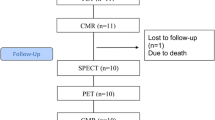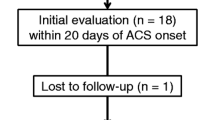Abstract
Background
Although reversible perfusion defects, perfusion-metabolism mismatch and match patterns are important for differentiating viable from nonviable myocardium, the frequency of these scintigraphic patterns has not been reported. The study objective was to establish the incidence of these scintigraphic patterns to estimate the clinical need for metabolic positron emission tomography for evaluating tissue viability in patients with prior myocardial infarction (MI).
Methods and Results
82Rb perfusion images were interpreted to identify reversible or irreversible defects, followed by determination of their 18F-fluorodeoxyglucose (18F-FDG) uptake pattern. In 155 patients with prior MI, analysis of 613 abnormal segments showed reversible perfusion defects in 13%. The 87% irreversible defects, 18% showed perfusion-metabolism mismatch, whereas 69% showed the match pattern. Reversible perfusion defects and perfusion-metabolism mismatches were noted in 20% (31/155) and 29% (45/155) of patients, respectively, whereas the match pattern was noted in 51% (79/155) of patients.
Conclusion
Irreversible perfusion defects were common in our patients with prior MI, and distinction between viable and nonviable tissue was not possible by perfusion imaging alone. The identification of hibernating myocardium was possible only with the additional 18F-FDG imaging in about one third of patients. This indicates a significant clinical demand for 18F-FDG imaging that identifies patients who will benefit from revascularization.
Similar content being viewed by others
References
Rahimtoola SH. A perspective on the three large multicentered randomized clinical trials of coronary artery bypass surgery for chronic stable angina. Circulation 1985;72(suppl):V123–35.
Rahimtoola SH. The hibernating myocardium. Am Heart J 1989; 117:211–21.
Tillisch J, Brunken R, Marshall R, et al. Reversibility of cardiac wall-motion abnormalities predicted by positron tomography. N Engl J Med 1986;314:884–8.
Go RT, Marwick TH, MacIntyre WJ, et al. A prospective comparison of rubidium-82 PET and thallium-201 SPECT myocardial perfusion imaging utilizing a single dipyridamole stress in the diagnosis of coronary artery disease. J Nucl Med 1990;30:1899–905.
Go RT, MacIntyre WJ, Saha GB, et al. Hibernating myocardium versus scar: severity of irreversible decreased myocardial perfusion in prediction of tissue viability. Radiology 1995;194:151–5.
Hicks RJ, Herman WH, Kalff V, et al. Quantitative evaluation of regional substrate metabolism in the human heart by positron emission tomography. J Am Coll Cardiol 1991;18:101–11.
Choi Y, Brunken RC, Hawkins RA, et al. Factors affecting myocardial 2-[F-18]fluoro-2-deoxy-d-glucose uptake in positron emission tomography studies of normal humans. Eur J Nucl Med 1993;20:308–18.
Gropler RJ. Methodology governing the assessment of myocardial glucose metabolism by positron emission tomography and fluorodeoxyglucose. J Nucl Cardiol 1994;1:S4–14.
Di Carli MF, Davidson M, Little R, et al. Value of metabolic imaging with positron emission tomography for evaluating prognosis in patients with coronary artery disease and left ventricular dysfunction. Am J Cardiol 1994;73:527–33.
Gibson RS, Watson DD, Craddock GB, et al. Prediction of cardiac events after uncomplicated myocardial infarction: a prospective study comparing predischarge exercise thallium-201 scintigraphy and coronary angiography. Circulation 1983;68:321–36.
Leppo JA, O'Brien J, Rothendler JA, Getchell JD, Lee VW. Dipyridamole-thallium-201 scintigraphy in the prediction of future cardiac events after acute myocardial infarction. N Engl J Med 1984;310:1014–8.
Vanoverschelde JLJ, Wijns W, Depré C, et al. Mechanisms of chronic regional postischemic dysfunction in humans. Circulation 1993;87:1513–23.
Carrel T, Jenni R, Haubold-Reuter S, von Schulthess G, Pasic M, Turina M. Improvement of severely reduced left ventricular function after surgical revascularization in patients with preoperative myocardial infarction. Eur J Cardiothorac Surg 1992;6:479–84.
Gropler RJ, Geltman EM, Sampathkumaran K, et al. Functional recovery after coronary revascularization for chronic coronary artery disease is dependent on maintenance of oxidative metabolism. J Am Coll Cardiol 1992;20:569–77.
Eitzman D, Al-Aovar Z, Kanter HL, et al. Clinical outcome of patients with advanced coronary artery disease after viability studies with positron emission tomography. J Am Coll Cardiol 1992;20:559–65.
Knuuti MJ, Nuutila P, Ruotsalainen U, et al. The value of quantitative analysis of glucose utilization in detection of myocardial viability by PET. J Nucl Med 1993;34:2068–75.
Bonow RO, Dilsizian V, Cuocolo A, Bacharach SL. Identification of viable myocardium in patients with coronary artery disease and left ventricular dysfunction: comparison of thallium scintigraphy with reinjection and PET imaging with 18F-fluorodeoxyglucose. Circulation 1991;83:26–37.
Dilsizian V, Freedman N, Bacharach SL, et al. Regional thallium uptake in irreversible defects: magnitude of change in thallium activity after reinjection distinguishes viable from nonviable myocardium. Circulation 1992;85:627–34.
Tamaki N, Kawamoto M, Tadamura E, et al. Prediction of reversible ischemia after revascularization: perfusion and metabolic studies with positron emission tomography. Circulation 1995;91:1697–705.
Takahashi N, Tamaki N, Kawamoto M, et al. Glucose metabolism in relation to perfusion in patients with ischemic heart disease. Eur J Nucl Med 1994;21:292–6.
Duvernoy C, Rothley J, Sitomer J, et al. Relationship of blood flow and functional outcome after coronary revascularization: the role of positron emission tomography [Abstract]. J Nucl Med 1993;34:155.
Parodi O, De Maria R, Oltrona L, et al. Myocardial blood flow distribution in patients with ischemic heart disease or dilated cardiomyopathy undergoing heart transplantation. Circulation 1993;88:509–22.
Mori T, Minamiji K, Kurogane H, Ogawa K, Yoshida Y. Restinjected thallium-201 imaging for assessing viability of severe asynergic regions. J Nucl Med 1991;32:1718–24.
Ragosta M, Beller GA, Watson DD, Kaul S, Gimple LW. Quantitative planar rest-redistribution 201Tl imaging in detection of myocardial viability and prediction of improvement in left ventricular function after coronary bypass surgery in patients with severely depressed left ventricular function. Circulation 1993;87:1630–41.
Gould KL, Yoshida K, Hess MJ, Haynie M, Mullani N, Smalling RW. Myocardial metabolism of fluorodeoxyglucose compared to cell membrane integrity for the potassium analogue rubidium-82 for assessing infarct size in man by PET. J Nucl Med 1991;32:1–9.
Author information
Authors and Affiliations
Rights and permissions
About this article
Cite this article
Go, R.T., MacIntyre, W.J., Cook, S.A. et al. The incidence of scintigraphically viable and nonviable tissue by rubidium-82 and fluorine-18-fluorodeoxyglucose positron emission tomographic imaging in patients with prior infarction and left ventricular dysfunction. J Nucl Cardiol 3, 96–104 (1996). https://doi.org/10.1016/S1071-3581(96)90001-X
Received:
Accepted:
Issue Date:
DOI: https://doi.org/10.1016/S1071-3581(96)90001-X




